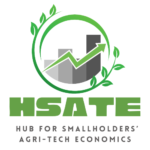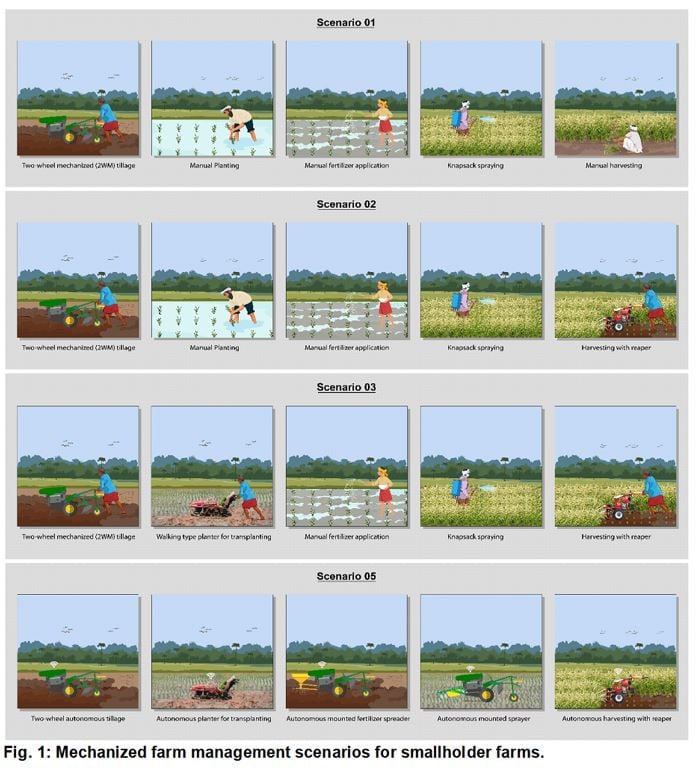Background
Approximately 500 million smallholder farms around the world, each typically spanning less than two hectares, serve as the backbone of agriculture in many regions (Nwanze, 2011; Lowder et al., 2016; FAO, 2010). The smallholder farms are primarily concentrated on Asia and Africa, support the livelihoods of nearly two billion people and play a crucial role in food and nutrition security, and rural economies (Onwude et al., 2016; Pingali, 2007; Lowenberg-DeBoer, 2022; Vortia et al., 2021). However, they face growing challenges, including labour shortages, rising wages, and irregularly shaped and sized fragmented fields that limit land and labour productivity. In Bangladesh, smallholder farming accounts for approximately 84.39% of agricultural households (Gurung et al., 2017). While Bangladesh has experienced a significant expansion of smaller-scale mechanization, particularly with single-cylinder diesel engines for irrigation and two-wheel machines (2WM), its level of agricultural mechanization remains comparatively less advanced than that of its neighbouring countries (Biggs & Justice, 2015). To tackle labour scarcity and promote agricultural intensification through mechanization, Bangladesh has launched several initiatives over the past few decades to achieve food self-sufficiency for its growing population. However, the country is yet to answer mechanization paradox prevailing whether to adopt two-wheel machines (2WM) and/or four-wheel machines (4WM) or retrofitted conventional machines for autonomy in arable grain-oilseed farms. The assessment of the economics of evolutionary mechanization is crucial to guide national agricultural mechanization policy (NAMP, 2020) linking with fourth industrial revolution (4IR), in agriculture known as Agriculture 4.0 (Rose and Chilvers, 2018) for guiding evidence-based policy suggestions. To shed light on the research gaps, this research project focuses on the following objectives: To help guide Bangladesh’s crop and mechanization alternatives selection, the study focuses on two-folds objectives: (i) assesses the economics of conventional human operated 2WM and 4WM, and (ii) evaluates whether low-cost retrofitted 2WM could be the long run sustainable solution.
Research methodology
This research embraces farm level ‘steady-state’ Hands Free Hectare-Linear Programming (HFH-LP) optimization model (Lowenberg-DeBoer et al., 2021) to evaluate smallholders’ farming settings of Bangladesh. It examines five mechanized farm management scenarios (Fig. 1) to assess the economic feasibility of mechanized systems including scenario 1 (mechanized tillage with all other operations manual); scenario 2 (mechanized tillage and harvesting with all other operations manual); scenario 3 (mechanized tillage, planting, and harvesting with all other operations manual); scenario 4 (whole farm conventional mechanization with human drivers); and scenario 5 (retrofitted autonomous farm mechanization). The first three scenarios are ex-post scenarios because Bangladesh arable grain-oilseed farming experiences on-farm and last two scenarios are ex-ante that the research also evaluates to guide short, medium and long-run policy suggestions. The enterprises modelled are wet season transplanted Aman rice known as Kharif-II (monsoon) crop, the dry season transplanted Boro rice well known as Rabi (winter) crop, and other Rabi crops namely wheat, maize, lentil (masur) and mustard. To gain deeper insights into the economic impacts, the base model will consider nationally representative secondary dataset of Rajshahi division for being one of the resource constraint regions of Bangladesh. The sensitivity analysis subsequently takes the advantage of cross-sectional data collected through Delphi method.
Research Implications
The research explores the potential of small-scale low-cost retrofitted autonomous mechanization, e.g., retrofitted 2WM as a profit maximizing solution subject to the binding on-farm resource constraints in smallholder farming context of Bangladesh, which may have implications for other smallholders’ settings in Asia and Africa. It envisages to guide the National Agricultural Mechanization Policy (NAMP) 2020 and smart farming transitions with evidence-based policy suggestions. The findings help to achieve Sustainable Development Goals (SDGs) covering targets, e.g., SDG 2.4 (ensuring sustainable and resilient food production systems with scale appropriate smallholder farms mechanization for increasing land productivity and climate resilient enterprise substitution), SDG-8.2 (economic productivity through diversification, technological upgrading and innovation), and SDG-8.3 (development-oriented policies to support productive activities), SDG-9.4 (upgrade infrastructure and retrofit industries). The academic implications of the research will encompass completion of two MS level theses, subsequently peer reviewed publications in journals like Agricultural Systems, Precision Agriculture, and Computers and Electronics in Agriculture.
Publications
1. Al-Amin, A. K. M. Abdullah, Antu, U.J., Azanta, M.L., Hossen, M.A., Banik, B., Hasan, M.A.A., Lowenberg-DeBoer, J., Aman, A., Rashid, M.H., Rahman, A., Hoque, M.A. (2024). Appropriate mechanization in Bangladesh for sustainable smallholders’ arable crop farming: From local adoption to scaling up. Initial economic modelling results submitted to International Growth Centre (IGC). https://doi.org/10.13140/RG.2.2.12732.65929
2. Hossen, M. A., Banik, B., Antu, U. J., Azanta, M. L., Hasan, M. A. A., Rashid, M. H., Rahman, A., Hoque, M. A., Lowenberg-DeBoer, J., Aman, A., Al-Amin, A. K. M. Abdullah (2024). Economics of labour saving agri-tech for smallholder farms: The case of Bangladesh. Contributed paper prepared for the 7th Symposium on Agri-Tech Economics for Sustainable Futures on 28-29 September 2024, University of Reading, U.K. https://doi.org/10.13140/RG.2.2.16421.92641
Funder
This study is funded by the International Growth Centre (IGC), which is directed by The London school of Economics and Political Science (LSE) and University of Oxford.
Project status
Ongoing
Research team
A. K. M. Abdullah Al-Amin; Umme Jaman Antu; Mysha Lamhiya Azanta; James Lowenberg-DeBoer; Aminul Aman; Anisur Rahman

